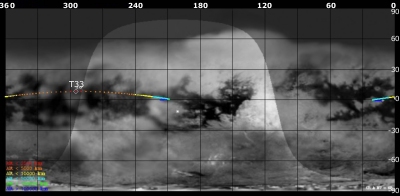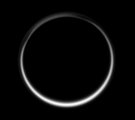Titan Flyby - 29 June 2007
27 June 2007
This Friday, 29 June 2007, Cassini returns to Titan for its thirty-fourth targeted encounter with Saturn's largest moon: Titan-33. The closest approach occurs at 16:59:46 UT, at an altitude of 1932 kilometres above the surface and at a speed of 6.2 kilometers per second. The latitude at closest approach is 8.1° N and the encounter occurs on orbit number 47.This encounter is set up with two manoeuvres: an apoapsis manoeuvre on 21 June, and a Titan approach manoeuvre on 26 June. This is the last in a series of nine outbound Titan encounters and occurs less than two days after closest approach to Saturn.
Science Highlights
- Radio Science Subsystem (RSS)
This is the third of three RSS Titan flybys in the nominal mission and two in the extended mission, covering a range of high and low inclination orbits near Titan's apoapsis and periapsis. It will be especially exciting to see what the T33 data reveal when combined with gravity passes during the earlier T11 (orbit 21) and T22 (orbit 36) flybys, while waiting for flybys T45 and T68. The flybys T11 and T22 were both at Titan apoapsis and provided consistent values of J2 and C22 (numbers that describe the gravitational field). T33 occurs at Titan periapsis and will provide the first opportunity to determine a preliminary value of Titan's Love number. This number is determined by the effect of tidal forces exerted on the moon, or put otherwise: it measures the flexibility of Titan. The final determination of the Love number is expected to tell us whether or not Titan has an internal ocean - Cassini Plasma Spectrometer
T33 is a polar and upstream encounter. Though some CAPS scientists find wake encounters more desirable, the upstream encounter allows a very good comparison to wake encounters such as T9. There will be good CAPS pointing for magnetospheric interaction, with corotation in view from closest approach-2 to closest approach+1 hour. There will be no turns during this interval, allowing for very stable CAPS pointing during this period. The lack of turns also simplifies data analysis over the several minutes needed to get a full 3-D distribution - no concern that the spacecraft is turning, which would complicate the analysis. The team anticipates a good data set for ionosphere and polar upsteam interactions - Ultraviolet Imaging Spectrograph (UVIS)
The team will obtain spectral images of Titan in the EUV and FUV to map the aurora and dayglow, to map hydrocarbon absorption, and to measure scattering and absorption by aerosols in the stratosphere - Composite Infrared Spectrometer (CIRS)
CIRS will perform high spectral resolution measurements of the atmosphere - Visual and Infrared Mapping Spectrometer (VIMS)
VIMS will obtain a global composition map at nearly full illumination and will perform monitoring for cloud motion and formation. VIMS will be searching for spectral signatures of dune fields, liquid hydrocarbons, and water and methane frost - Imaging Science Subsystem (ISS)
ISS will be performing high-resolution (120-240 m/pixel) imaging of the equatorial bright-dark boundary around 1° N, 215-210° W (low phase angle coverage - 20-15°), and will do regional-scale (240-500 m/pixel) mapping of the equatorial bright-dark boundary around 1° N, 210° W (very low phase angle ~13°)
Table of Events
11 June 2007
| Time UTC | Time wrt Titan-33 |
Activity |
| 03:10:00 | -18d 14h | Start of sequence S31 which contains Titan-33 |
26 June 2007
| Time UTC | Time wrt Titan-33 |
Activity |
| 17:08:00 | -02d 24h | OTM #118 prime. Titan-33 targeting manoeuvre |
27 June 2007
| Time UTC | Time wrt Titan-33 |
Activity |
| 08:10:00 | -02d 09h | OTM #118 backup |
28 June 2007
| Time UTC | Time wrt Titan-33 |
Activity |
| 00:00:37 | -01d 17h | Descending ring plane crossing |
| 00:53:30 | -01d 16h | Saturn periapse, R = 2.5 RS, lat = -1°, phase = 126° |
29 June 2007
| Time UTC | Time wrt Titan-33 |
Activity |
| 02:05:00 | -14h 54m | Start of the TOST segment |
| 02:05:00 | -14h 54m | Turn cameras to Titan |
| 02:35:00 | -14h 24m | Deadtime, 9 minutes and 46 seconds long. Used to accommodate changes in flyby time |
| 02:44:46 | -14h 15m | Titan atmospheric observations. Obtain information on CO, HCN, CH4. Integrate on disk at airmass 1.5-2.0 |
| 06:59:46 | -10h 00m | ISS Imaging. WAC Photometry and NAC Global Mapping. Particle properties, vertical distributions ~6 km per pixel |
| 07:59:46 | -09h 00m | RSS Titan gravity field determination. Part 1 of 3 |
| 11:59:46 | -05h 00m | Titan atmospheric observations. Exobase observations on anti-Sun side |
| 14:59:46 | -02h 00m | RSS Titan gravity field determination. Part 2 of 3 |
| 16:59:46 | +00h 00m | Titan-33 Flyby Closest Approach Time. Altitude = 1932 km, speed = 6.2 kms-1, 96° phase at closest approach |
| 17:44:46 | +00h 45m | Titan surface observations. High-resolution cubes of Titan's surface |
| 18:59:46 | +02h 00m | ISS Imaging. NAC regional map |
| 20:59:46 | +04h 00m | Titan atmospheric observations. Obtain information on surface & tropopause temperatures, and on tropospheric CH4. Scan or contiguous steps across disk |
| 22:14:46 | +05h 15m | RSS Titan gravity field determination. Part 3 of 3 |
30 June 2007
| Time UTC | Time wrt Titan-33 |
Activity |
| 01:44:46 | +08h 45m | New waypoint |
| 02:14:46 | +09h 15m | Titan atmospheric observations. Obtain information on CO, HCN, CH4. Integrate on disk at airmass 1.5-2.0 |
| 06:59:46 | +14h 00m | Titan surface observations. Global map |
| 12:59:46 | +20h 00m | Deadtime, 18 minutes and 19 seconds long. Used to accommodate changes in flyby time |
| 13:51:00 | +20h 52m | Turn to Earth-line |
Titan Ground Trace
 |
|
Image courtesy NASA/JPL/Space Science Institute |
The above image shows the ground trace of the Titan-33 flyby on a mosaic of Titan's surface, for a period of 32 hours around closest approach. The colour of the trace indicates Cassini's altitude above the surface. Blue: > 100 000 km, green: < 100 000 km, light blue: < 50 000, yellow: < 10 000 km, orange: < 5000 km, red: < 2000 km (not reached during this flyby). The point of closest approach is marked T33. Cassini approaches Titan over the equatorial region, near latitude -1° (centre right in this image) at 16 hours before closest approach, and then continues to pass over Titan's northern hemisphere.
Observation Results
Cassini Instrument: Imaging Science Subsystem (ISS)
|
Date: 16 August 2007 Credit: NASA/JPL/Space Science Institute Image Notes: Backlit view of Titan shows the moon's atmosphere in scattered sunlight, with the detached high-altitude haze layer. |
 |

